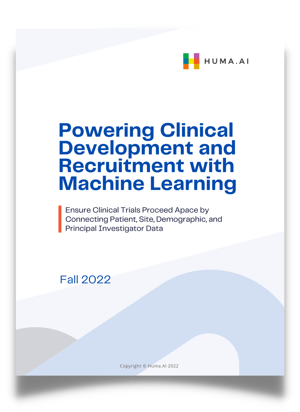Over the past decade, artificial intelligence (AI) and machine learning (ML) has become the breakthrough technology most likely to transform how pharmaceutical companies conduct research and development.
This trend is driven by revolutionary advances in computational technology and the resulting end to previous constraints to collecting and processing large volumes of data. Meanwhile, the cost of bringing new drugs to market and to patients has become prohibitively expensive. Recognizing these headwinds, AI/ML techniques appeal to pharmaceutical companies because they use automated processes, are predictive, and are, therefore, most likely to increase efficiency. Pharmaceutical companies have started using ML approaches in drug discovery for about 15-20 years with increasing sophistication.
The most recent application for ML techniques is in clinical trial design, conduct, and analysis.

Machine learning (ML) is a field of inquiry devoted to understanding and building methods that leverage data to improve performance on some set of tasks. When applied to clinical trials, machine learning can be used to develop predictive models that identify which patients are likely to respond to a given treatment or which patients are at risk of adverse events. The use of machine learning in clinical trials is still in its early stages, but the potential benefits are clear. With further development, machine learning could become an invaluable tool for optimizing clinical trial design and improving patient outcomes.
Identifying Patients Most Likely to Respond to Treatment
One area where machine learning could have a significant impact is in the identification of patients who are likely to respond to a given treatment. In many clinical trials, patients are randomly assigned to receive either the experimental treatment or a control treatment. However, this approach is not always ideal, as some patients may not respond to the experimental treatment, while others may experience adverse events. By using machine learning to develop predictive models, it may be possible to identify which patients are most likely to respond to the experimental treatment and target them for enrollment in clinical trials. This would improve the chances of success for clinical trials and reduce the number of patients exposed to potentially ineffective treatments.
According to the journal Trials, “Improved selection of specific patient populations for trials may decrease the sample size required to observe a significant effect. Put another way, improvements to patient population selection may decrease the number of patients exposed to interventions from which they are unlikely to derive benefit.”
Identifying Patients Most Likely to Have an Adverse Event
Another area where machine learning could be beneficial in identifying patients at risk of adverse events. Adverse events are a significant problem in clinical trials and can often lead to trial discontinuation. By using machine learning to develop predictive models, it may be possible to identify which patients are at risk of adverse events and target them for closer monitoring. This would improve patient safety and increase the chances that a trial would be completed successfully.
According to the Spine Journal, for example, predictive models of AE occurrence after spine surgery procedures could be designed by integrating multiple administrative claims databases and encompassing privately and publicly insured patients, providing greater accuracy in predicting the risks of AEs.
Driving Drug Discovery and Development
In recent years, AI and ML have been used to develop new drugs for various conditions, including cancer, heart disease, and Alzheimer's. In each case, these techniques have helped to reduce the time and cost associated with traditional drug development methods.
As AI and ML continue to evolve, their impact on drug development will likely become even more pronounced. In the future, these technologies could create personalized medicines explicitly tailored for each patient. Additionally, AI and ML could be used to develop new drugs faster than ever, making it possible to bring life-saving treatments to market in months instead of years.
Nevertheless, according to an article in Drug Discovery Today, “The entire success of AI depends on the availability of a substantial amount of data because these data are used for the subsequent training provided to the system. Access to data from various database providers can incur extra costs to a company, and the data should also be reliable and high quality to ensure accurate result prediction.”
As a result, major players in the industry have partnered with technology start-ups that specialize in utilizing ML and AI, which integrate data.
Why Data Integration is Critical
“Drug discovery and development is a long, costly, and high-risk process that takes over 10–15 years with an average cost of over $1–2 billion for each new drug to be approved for clinical use”, according to Acta Pharmaceutica Sinica B.
Due to the high costs associated with drug development, pharmaceutical companies are constantly searching for ways to reduce these expenses while still producing effective treatments.
According to Intelligent Medicine, AI and ML “may reduce the need for clinical trials and live study participants, which would be beneficial from both financial and ethical standpoints.”
The same article goes on to identify a blocker to progress, however:
“One problem is inefficient data integration. This problem results from diversity between datasets, which may comprise raw data, processed data, metadata, or candidate data. These datasets must be collected and collated for efficient analysis, but currently, there is no established method.”
By using this emerging technology, researchers can more accurately predict a potential drug's efficacy and safety profile, making it easier to identify potential candidates for clinical trials - when data is clean enough to be leveraged.
In Summary
Researchers must establish a more efficient method of collecting and collating data. This could be done by partnering with AI and ML companies to integrate datasets from multiple providers, utilizing advanced algorithms to clean and process the data, and then utilizing these datasets to train predictive models that can accurately predict which patients will be more responsive in clinical trials, as well as those with greater risk for of AEs. By doing so, drug discovery and development efforts will be able to move faster, reduce costs, and ultimately save lives.
Want Deeper Clinical Trials Insights?
Finding the sites and principal investigators to conduct trials is no small task.
With Huma.AI , however, a single intelligence layer is placed over a wide variety of data sets pulled from almost any source.
Huma.AI uncovers deeply buried clinical trial insights that give clinical professionals the highly targeted intelligence and market advantage needed to create more successful trials.
Book a free demo to see how Huma.AI can boost your clinical intelligence.
.png?width=300&height=120&name=Huma-AI-Logo-(Horizontal).png)



.png?width=200&name=Huma-AI-Logo-(Horizontal-Reverse).png)